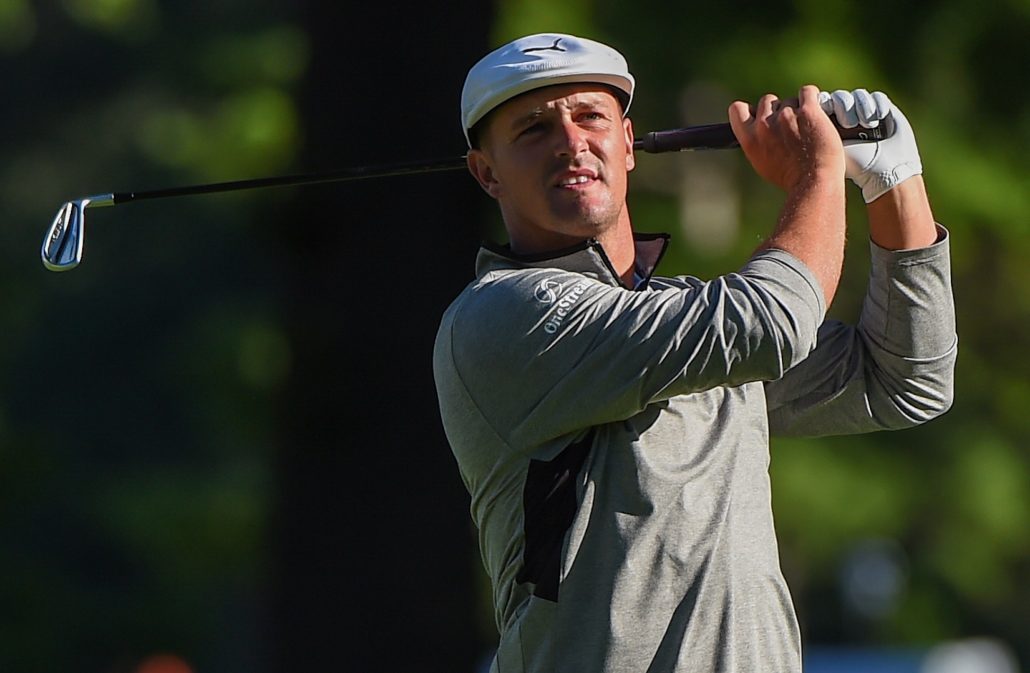Bryson DeChambeau certainly has been making a noise in the world of golf over the past few years. Having spent a few weeks out on the PGA Tour recently, I got a closer look at what he is up to.
He has no problem thinking outside the box. When he was 17, DeChambeau fashioned his own set of single-length irons. They were all the length of a traditional 6-iron and he’s been playing same-length irons ever since. Of course he has also fashioned a swing to work with those irons: he stands and swings much more upright and he uses a single-plane swing.
His irons are equipped with fat grips and he holds those grips more in the palm than in the fingers. The clubheads are all identical weights; the lie angles are all identical and about 10 degrees more upright than you would find on a standard set of irons.
DeChambeau says the point of all of this is to ‘create a swing that’s consistent from club to club, that doesn’t have a lot of moving parts to mess up’.
The idea of a set of irons where all the clubs, from the 3-iron to the wedges, are the same length, is not new. However, single-length irons are getting much more attention these days, thanks to him. The idea for single-length irons goes back to the 1930s, perhaps even earlier.
But from then until DeChambeau showed up, one-length irons were rarely seen and if they were, they were only made by small, niche companies.
So what is the attraction of such a set of golf clubs? Those who advocate for same-length irons believe they are designed for easier and more effective play. There is no need to move the golf ball forward or back in your stance depending on the club used, no resetting to adjust to a club’s length, and no swinging more or less upright to adjust to club length. This is the major selling point and should benefit golfers of all skill levels.
But this simplifying of the set-up/swing might especially benefit beginners and high-handicappers. Another benefit is that shots with the higher-numbered irons and wedges in the set tend to carry further than with traditional irons. This has been extremely noticeable with DeChambeau.
But there are detractors, too, who believe single-length irons make distance control and proper yardage-gapping more difficult and that amateurs don’t have the swing skills to make the best use of them.
The good news for the future of single-length irons is that new designs and emerging materials and technology should be able to address the cons on this list.
Proper club-fitting is essential for a golfer who is considering one-length irons.
In addition to single-length irons, DeChambeau has also made significant changes to his putting. He used an Edel Brick putter when he burst on to the scene as an amateur. It was eye-catching due to its pronounced, rectangular shape, but that was the only slightly unconventional thing about his putting style.
Today DeChambeau has adopted an almost entirely different technique. His arms are much straighter, his putter is more upright and he’s using an arm-lock style.
So what prompted him to change? In 2017, DeChambeau finished the season 145th in strokes gained for putting. After a short-lived experiment with ‘side-saddle putting’, he settled on his new arm-lock method and jumped to 32nd and 28th in the putting rating the following two seasons, and last year he finished 10th on those putting stats. His putting coach dropped some interesting insight about the method they have been working on.
DeChambeau now has an engineer’s approach to putting, building it around limiting the number of moving parts. He’s trying to make it all about angles and limiting the variables. At address, he rotates his left upper arm inwardly to its maximum range of motion at the shoulder, and then he’s trying to take his lead left wrist and rotate his forearm as far in the opposite direction as it can possibly go, to its maximum range of motion. Then when you look at his trail arm and trail joints, he’s trying to do exactly the opposite. So, in a nutshell, he’s trying to lock these joint capsules in place at their maxed-out range of motion so there’s nowhere for them to go. He’s locked in. Then he just has to rock his shoulders.
DeChambeau spends the better part of the preparation days on the putting green calibrating his stroke length to the speed of the greens. He then knows that a length of stroke from ‘big toe to big toe’ goes a certain distance. Then he matches that by pacing out every putt before he hits it on the course and adjusts his stroke length accordingly.
The most noticeable change has been DeChambeau’s pursuit of more distance and the changes he’s made to his body. He has been working with strength coach Greg Roskopf to gain more muscle and increase his speed capabilities. It’s worked as he’s gained 12kg of lean muscle mass. DeChambeau also does speed training to teach his central nervous system how to fire faster.
The training allows him to use a heavier driver, thereby increasing the mass component. Multiply that by swinging it as fast as he can, the acceleration component, and the result is more force imparted to the ball. This is why he has a fascination with ball speed. We know this works as there is a direct correlation with driving distance and money earned on the PGA Tour.
ALSO READ: How to get more restful sleep
– This column first appeared in the November 2021 issue of Compleat Golfer magazine. Subscribe here!









